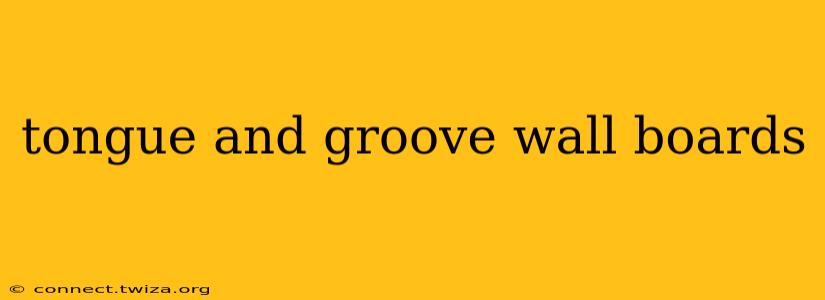Tongue and groove wall boards offer a classic and versatile solution for interior wall cladding, bringing warmth, character, and a touch of rustic charm to any space. This comprehensive guide explores everything you need to know about tongue and groove wall boards, from understanding their features and benefits to installation and maintenance.
What are Tongue and Groove Wall Boards?
Tongue and groove wall boards are wooden planks designed with interlocking edges. One edge features a "tongue" – a raised projection – while the opposite edge has a corresponding "groove" – a recessed channel. This ingenious design allows the boards to fit together snugly, creating a seamless and secure wall covering. The interlocking system minimizes gaps, enhancing insulation and reducing drafts. They are available in a variety of wood types, finishes, and thicknesses, offering extensive design flexibility.
What are the Benefits of Tongue and Groove Wall Boards?
Aesthetic Appeal: Tongue and groove boards offer a timeless and visually appealing finish. The natural wood grain adds warmth and character to a room, creating a cozy and inviting atmosphere. They can be stained or painted to complement any décor style.
Durability and Longevity: High-quality tongue and groove boards are exceptionally durable and long-lasting. With proper care and maintenance, they can withstand the test of time, adding lasting value to your home.
Insulation and Soundproofing: The tight fit between boards provides excellent insulation, helping to regulate room temperature and reduce energy costs. The dense wood also acts as a natural sound barrier, improving soundproofing within the room.
Easy Installation: While some DIY experience is helpful, tongue and groove boards are relatively straightforward to install compared to other wall cladding options. The interlocking system simplifies the process and minimizes the need for complex joinery.
Versatile Application: Tongue and groove wall boards are suitable for various applications, including feature walls, entire rooms, and even ceilings. They can be used in both residential and commercial settings.
What Types of Wood are Used for Tongue and Groove Wall Boards?
Many different wood types are used, each with its own characteristics:
- Pine: A popular choice due to its affordability, light color, and ease of workability. Pine is readily available and easily stained or painted.
- Cedar: Known for its beautiful reddish hue, natural resistance to rot and insects, and pleasant aroma. Cedar is a premium option often used in bathrooms and outdoors.
- Oak: A strong, durable hardwood offering a rich, luxurious look. Oak tongue and groove boards are a more expensive choice but offer exceptional longevity.
- Redwood: Another durable and rot-resistant option, known for its deep red color and strength.
How Much Does Tongue and Groove Wall Cladding Cost?
The cost of tongue and groove wall boards varies significantly depending on the wood type, thickness, finish, and supplier. Generally, pine is the most affordable, while hardwoods like oak and cedar command higher prices. The cost also depends on the area to be covered and whether you hire professionals for installation.
How to Install Tongue and Groove Wall Boards?
Installation involves several steps, including preparing the wall surface, measuring and cutting boards, and securing them to the wall using appropriate fasteners. While many DIYers successfully install these boards, proper preparation and execution are key to a professional-looking finish. Detailed instructions are readily available online and in DIY guides.
How to Maintain Tongue and Groove Wall Boards?
Regular cleaning with a damp cloth and mild detergent will keep your tongue and groove wall boards looking their best. Avoid harsh chemicals or abrasive cleaners. Periodically inspecting for damage and addressing any issues promptly will help prolong their lifespan. Re-staining or repainting might be necessary over time, depending on the wood type and finish.
What are the Different Finishes Available for Tongue and Groove Wall Boards?
Tongue and groove boards can be finished in various ways, including:
- Unfinished: Allowing you to choose your own stain or paint.
- Pre-finished: Coming with a factory-applied stain or paint, saving time and effort.
- Distressed: Offering a rustic, aged look.
- Smoked: Giving a darker, richer tone.
This guide provides a comprehensive overview of tongue and groove wall boards. Remember to always consult professional advice for large projects or if you lack confidence in DIY tasks. The right choice of wood and installation technique will significantly impact the final aesthetic and lifespan of your beautiful new wall cladding.
